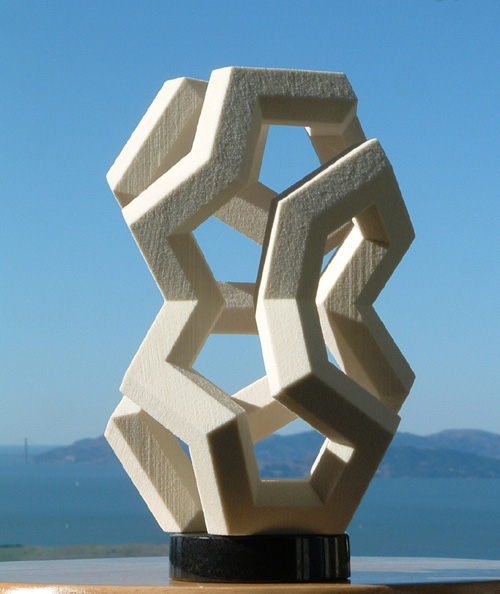CS 285: SOLID MODELING
Lecture #7 -- Tue, Sep. 18, 2007.
PREVIOUS < - -
- - > CS 285 HOME < - -
- - > CURRENT < - -
- - > NEXT
Warm-up Thinking Exercise:
How do you get a sweep along a (crooked) closed curve to close "gracefully" on itself ?

Some Basic Concepts Behind the Sweep Implementation in SLIDE
The Frenet frame:
-
Finding the Tangent
-
Normal Plane
-
Osculating Plane
-
Normal vector
-
Binormal
-
Difference between Normal and second derivative
-
The three coordinate planes and their relations to the 3 vectors.
Foundation: Sweeps along piecewise linear paths.
-
How to properly join cylidrical tubes at an angle.
-
How to join prismatic tubes, so edges line up.
-
"Azimuth" and "axturn".
-
How to calculate the torsion minimizing azimuths.
-
The "twist" parameters.
Closed prismatic loop.
Sweeps along smooth curves.
- Any smooth curve in computer graphics becomes piecewise linear at some point.
The sweep parameters in SLIDE.
Visualization of Symmetry Groups Using Shape Generator Programs
7 families of rotational groups based on the 7 friezes wrapped around a cylinder: Cn, Dn, S2n, Dnd, Cnh, Cnv. Dnh.
7 groups of "really 3D" (more spherical) symmetries based on the Platonic and Archimedean solids.
From a Graphical Design to a Realizable 3D Solid Part
On the example of Escher tiles:
Just partitioning the sphere surface in a graphical manner is not enough:
- Need to distill out an individual tile;
- Need to give the tile some thickness,
- and possibly some relief in the form of a height field;
- Need to provide a (possibly simpler) back-surface;
- Need to connect these two surfaces into a coherent B-rep with side walls;
- Also may have to figure out a coloring pattern for the various tiles.
Representations for Solid Modeling
Many possible concerns -- many possible items on the wish-list:
- What is easiest way for the designer to describe the part:
-- instancing, boolean operations, maintain symmetry, allow controlled space warps, ...
- What is the best way to visualize the result of a designer's input:
-- interactive speed, resolve booleans to screen resolution, rendering enhancements: shadows, depth queues ...
- How can a possible design most easily be analyzed for consistency, volume, weight distribution, srength, ...:
-- need to deal with volumetric information explicitly: tetrahedralization, finite-element meshing, voxelization, ...
- How can the finished design best be transmitted to someone else:
-- description needs to be unambiguous, precise, efficient, easy to parse and process, ... (unlike .STL).
- What is the best representation for the manufacturing process:
-- primitives relevant to the manufacturing process -- strongly depends on type of process: - Layered manufacturing: Collection of 2D contours or raster maps corresponding to each slice level.
- Machining on a milling machine: Starting shape plus a
collection of features (pockets, drill holes) that need to be removed.
What are the building blocks for these representations ?
How do we know that we have a viable, consistent SOLID model ?
Current Homework Assignment#4: (Due 9/20/07: 08 am, electronically)
Use the sweep facility in SLIDE to generate your monogram.
PREVIOUS < - -
- - > CS 285 HOME < - -
- - > CURRENT < - -
- - > NEXT
Page Editor:
Carlo H. Séquin